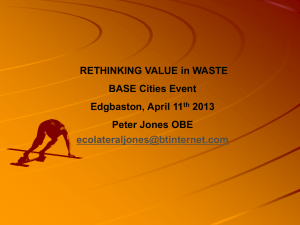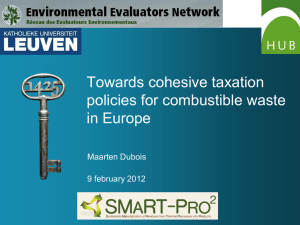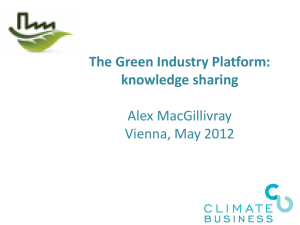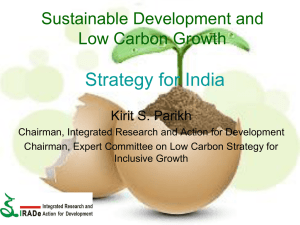Zhejiang Pinghu municipal solid waste incineration Project, China
advertisement
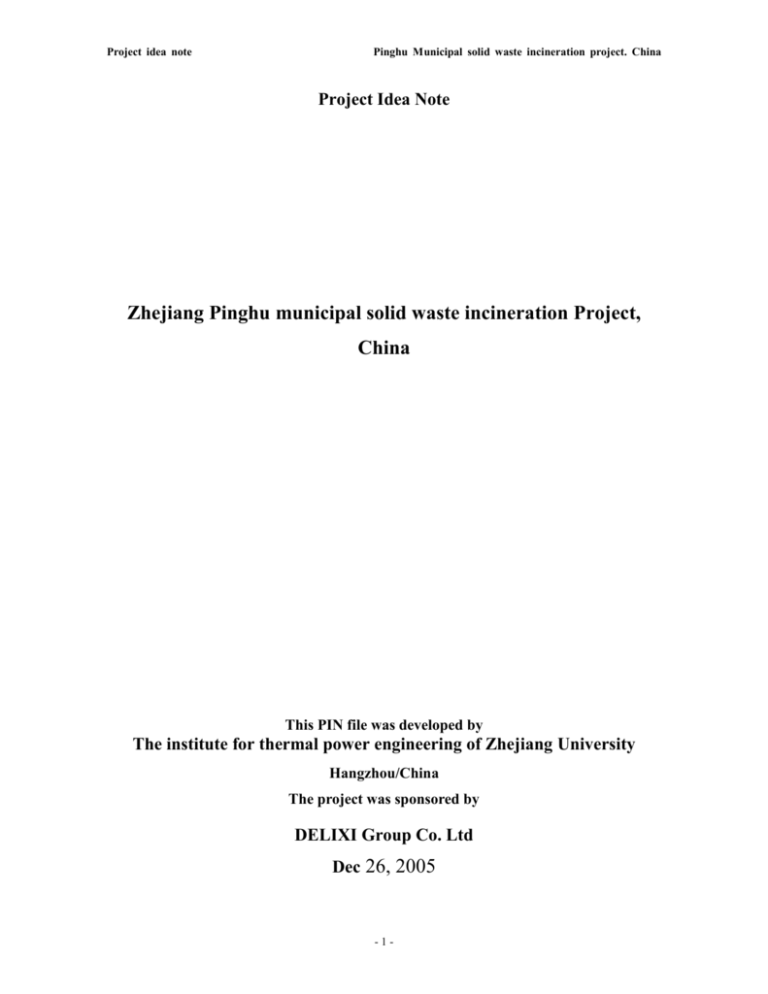
Project idea note Pinghu Municipal solid waste incineration project. China Project Idea Note Zhejiang Pinghu municipal solid waste incineration Project, China This PIN file was developed by The institute for thermal power engineering of Zhejiang University Hangzhou/China The project was sponsored by DELIXI Group Co. Ltd Dec 26, 2005 -1- Project idea note Pinghu Municipal solid waste incineration project. China PROJECT IDEA NOTE Name of Project: Zhejiang Pinghu municipal solid waste incineration project, China Date submitted: Dec 25, 2005 A. Project description, type, location and schedule General description Project objective Project description and proposed activities The proposed project includes building a MSW direct incineration plant with heat recovery facilities to generate electrical power. About 600 toners per day (TPD) of MSW will be incinerated to generate 18MW (gross) electricity. It is a normally underdeveloped city with approximant 500,000 residents. About 500 tons waste is generated each day in the city and the figure is increasing about 8~10% year by year. Till now there is only one simple landfill plant which located in Dingyun village. If the CDM project has not been adopted, in order to dispose the waste generated and will generate, a scale more than 600t/d landfill plant should be build with the capacity about 4,000,000m3 of 20 years lifetime. Based on current government regular requirement and local economic conditions, no sanitary facilities would be installed such as gas and leakage collection and recovery system, and it is also difficulty to keep the isolate from surrounding soil and groundwater. From a techniques view, this kind of landfill belongs to dumping disposal which currently is BAU in China. The proposed CDM project includes setting up of a Municipal Solid Waste processing plant by direct incineration techniques with heat recovery facilities to generate electrical power. About 600 toners per day (TPD) of MSW will be incinerated to generate 18MW (gross) electricity. All the wastes are intending to be simple dumped under business as usual way. Greenhouse gas reduction results from: 1. Displacement of simple dumping treatment avoiding methane release during anaerobic organic waste decomposition. 2. Displacement of fossil fuel consumption from power generation through heat recovery system. The scheme of the project is describe in figure below: -2- Project idea note Pinghu Municipal solid waste incineration project. China The MSW would be collected by road sweepers and transport to the plant by sanitation airtight vehicles. After simple assort treatment (pick out non-organic materials such as metal, glass, and bricks, etc,) , the simple-treated waste would be directly throw into two incinerators (another one for failure stand-by ) by belt conveyors, and all carbon element would be converted into CO2, and the heat energy would be recovery for electrical generate (18MW) by stream turbulent after self-consuming (about 20% electricity to operate the incineration machines including air fan and pumps), redundant electrical would be send into local regional grid. Combustion residues including fly ash and slag would be solidified by cement. The plant shall be operating for 23 hours a day for about 300 days in a year and thus process total 219000 tones of waste and 124.2 Million Units of electricity annual. Technology to be employed In this project, the Circulating-Fluidized-Bed incineration technique will be employed. Project proponent submitting the PIN The institute for thermal power engineering of Zhejiang Name University Organizational category Non Governmental Organization Other function(s) of the project developer in the project Summary of relevant experience Technical advisor Address 38 Zheda Road, Hangzhou, 310027, P.R China Contact person Prof. Yan jian hua Telephone / fax (86)571-87952443-8211 E-mail and web address yanjh@cmee.zju.edu.cn www.ceee.zju.edu.cn The institute is developing waste thermal treatment techniques to reduce GHG over years, and has helped government to build more than 10 MSW incineration power plants around China which do a great favor to Chinese GHG reduction task. Project sponsor(s) financing the project (List and provide the following information for all project sponsors) Name Zhejiang DELIXI Group Co., Ltd Organizational category Private company Address (include web address) Liuqing Road No.1 Delixi Mansion, Liushi Wenzhou, Zhejiang Province, China http://www.delixi.com/ Manager project Main activities Summary of the financials (total assets, revenues, profit, etc.) DELIXI Group Co., Ltd., established in 1984 and headquartered in Zhejiang wenzhou, is one of the two largest private enterprises in China. Now DELIXI has about 10,000 employees, and Its revenue in 2001 was about $ 790 million. Through years of development -3- Project idea note Pinghu Municipal solid waste incineration project. China DELIXI has expanded its business into more than 40 countries. Type of project Greenhouse gases targeted CO2 / CH4 Type of activities Abatement Field of activities (Select code(s) of project category(ies) from the list) d. Waste management/utilization of waste Location of the project Region East Asia Country China City, Country PingHu city, Zhejiang province, China Brief description of the plant or facility site The plant is located in the west side of the BinHai No.2 road of QuanTang town in PingHu Dushan Harbor District Expected schedule Earliest project start date (Year in which the project will be operational) Estimate of time required before becoming operational after approval of the PIN 10/01/2006 Time required for financial commitments: 6 months Time required for legal matters: 2 months Time required for negotiations: 2 months Time required for establishment: 20 months Expected first year of CER / ERU 2008 / RMU / VER delivery Project lifetime (Number of years) 20 years Current status or phase of the feasibility study finished project Current status of the acceptance Letter of Endorsement is under discussion of the Host Country The position of the Host Country d. with regard to the Kyoto Protocol signed and has demonstrated a clear interest in becoming a party (mention what is applicable) in due time (e.g., countries which have already started or are on the verge of starting the national ratification, acceptance or approval process); -4- Project idea note Pinghu Municipal solid waste incineration project. China B. Expected environmental and social benefits The below methodology for the calculation of baseline emissions and project emissions is based on the IPCC guidelines for waste treatment, and on the approved baseline methodology AM0010 "Landfill gas capture and electricity generation projects where landfill gas capture is not mandated by law", and on Executive board methodology ID "Indicative simplified baseline and monitoring methodologies for selected small-scale CDM project activity categories" for the use of electricity bought from the grid. The calculation of emissions is divided into direct emissions (for converting fossil-origin carbon from CH4 emission to CO2 emission) and indirect emissions (for energy production). Overall proposed incineration technique description The project proposed here is to replace simple landfill plant by incineration techniques. The advantages of incineration very obviously: Saving land resource, comparing with landfill, a lot of land resource would be saved which is very importing for developed region. Right now treatment method, the waste will be treated about 2 or 3 days after rejecting, this character is very usefully for large cities or metropolitans. Avoid leakage, the waste water leakage of landfill is unavoidable for simple constructed landfill in China which cause severe underwater and soil contamination. Estimate of carbon sequestered or conserved (in metric tonnes of Avoid methane emission and odour gas dispersal, the methane CO2 equivalent or tCO2e) contributes great to world climate worming, and odour gas will great effect neighborhoods. Energy recovery, through incineration, the heat energy could be recovered to generate electrical power which would substitute fossil fuel consumption of the local grid. Emissions from landfill If the incineration CDM project would not be approved and without any extra financially support, a BAU landfill plant will be constructed based on current technique level to deal with the MSW generate daily by municipal government. As there are no practical gas capture and recovery facilities of the landfills constructed in the past decades around China, the GHG would emit to atmosphere totally during the anaerobic and aerobic biodegrading procedure of the carbon origin material including methane (CH4), carbon dioxide (CO2), and hydrogen sulphide (H2S) and nitrogen components (N2, NH4, N2O) while the emissions of methane and carbon dioxide are absolutely dominant compared to other gases. As the CO2 emissions are biomass original could be set to zero. So for landfill constructed normally in China, only CH4 emissions are concerned. Emissions from incineration If the CDM project would be approved, a MSW incineration plant would be constructed. The combustion of the waste would release -5- Project idea note Pinghu Municipal solid waste incineration project. China carbon dioxide, methane and nitrogen dioxide, and a small quantity of other gases which will not be concerned in this methodology. In emissions, methane is likely to be insignificant because of the combustion conditions in incinerators such as high temperatures and long resident times. And the emissions of CO2 are much greater than N2O. According to the IPCC Guidelines, only CO2 emissions resulting from the incineration of carbon in waste of fossil origin (e.g. plastics, certain textiles, rubber, liquid solvents, and waste oil) should be included in emissions estimates. The carbon fraction that is derived from biomass materials (e.g. paper, food waste, and wooden material) is not included. So for incineration plants, emissions of CO2 and N2O are concerned. CO2 emissions from electricity production For landfill plant the electricity consumption is relatively insignificant. While the waste incineration plants use electricity for several purposes, especially for the waste pre-treat machines, air fans, dust-filters, and etc. When this electricity consumption is bought from the grid it can have coursed CO2 emissions from grid-connected power plants which burning fossil fuel. In this project, through incineration, the energy in the waste can be used for energy purposes, e.g. electricity and heat production by use of a gas engine. This energy production can by part of the project, and in such case the CO2 savings due to the amount of electricity that is produced shall be claimed. The electricity consumption at the plant is assumed to be proportional to the amount of generate. And the redundant electricity can be sent into the grid. Therefore the electricity consumption in the baseline will be dynamic and based on annual waste treatment amount and electricity generated. Total GHG emission reducing The total GHG emissions between the baseline and the proposed project could be expressed as followings: Baseline Emissions = CH4 emissions Project Emissions = CO2 emissions due to combustion + N2O emissions due to combustion + CO2 emissions due to electrical change In which: CO2 emissions due to electrical consumption= (Electrical consumed - Electrical produced)×CO2 emission rate. “What is important is the GHG emissions reduction due to CDM project”. The Emissions saved = Baseline Emissions – Project Emissions; The following description gives detail calculation for the emissions saving -6- Project idea note Pinghu Municipal solid waste incineration project. China The following estimating figures indicate the total GHG reduced on a scenario. The actual emissions reductions will probably be much higher because leakage always happens for landfill, but this fact should be ratified with field tests carried out at site. The crediting period of the project runs from 2008 to 2028. Per year (average until 2028): 161873.85 ton CO2eq/year Accumulated in lifespan(20 years): 3237477.00 ton CO2eq Accumulated in 10 years: 1618738.50 ton CO2eq Accumulated until year 2028: 3237477.00 ton CO2eq The baseline of this project is a supposed 600t/d landfill plant and local chemical factory’s requirement for heat and electric. The supposed landfill plant is normal constructed with gas chimney installed burning the CH4 for safe reason. Which emissions is the proposed CDM project displacing? Baseline scenario (What would the future look like without the proposed project? What would the estimated total carbon sequestration / conservation be without the proposed project?) In the MSW direct incineration project proposed at Pinghu city, all the waste will be burned directly by CFB facilities which generate requirement for local factories at the same time. So all the carbon original in the waste will be converted into CO2 which come from biomass, the project also avoid the fossil fuel consumption for electric and overheated stream generating. The estimated reduced GHG is about 253,434.9 ton CO2eq each year. Clearly the emissions are greatly reduced, if the CDM project would be implemented, because CO2 emissions from the waste combustion result from biomass and can therefore be set zero. What would the future look like without the proposed project? If the CDM project is not implemented, The local government would build a 600t/d landfill plant which will consume 200000m2 land resource and release 117096.672 ton equivalent CO2 per year. And as the simple treatment facilities, the under water will unavoidable be polluted due to leakage. And also there will be odour smell all around the disposal site. Describe the project barriers (finance, market, institutional, legal, and technological).What are the solutions to these problems? Investment – the MSW direct incineration project incineration project inherent capital costs with a proven technology and know-how are substantial. The selling of CERs could guarantee and provide the necessary financial support needed for GHG emissions released by the supposed landfill and fossil fuel combustion. Technological – there are no suppliers of equipment/technology and know-how of these features in Pinghu. LFG recovery and utilization technology has not been applied to dumpsites/landfills in medium size -7- Project idea note Pinghu Municipal solid waste incineration project. China cities in Pinghu. Not common practice – common practice in China for solid waste treatment is land filling which emitting a lot of CH4, the methane recovery techniques in China is very inefficient. Which politics, strategies, laws etc. affects the project activities? Global benefits Local benefits There is no legislation in China for landfill gas emission control. Most landfill plant in China burn the gas only for safety purposes. Nevertheless, this is not a common practice; The efficient flaring of landfill gas, active collection/extraction and generation of electricity or thermal energy are not common practice. And It is unlikely that legislation can be expected in the coming decade to enforce efficient LFG flaring. Landfill gas has two primary constituents’ methane (CH4) and carbon dioxide (CO2) which are GHG; however, methane is a gas with a Global Warming Potential (GWP) of 23 times higher than carbon dioxide. The proposed project activity will total reduce the GHG emissions by transforming CH4 into CO2, thus lowering the GWP of the landfill business as usual operations. Local Benefits: Technical Recovery of solid waste Self-Generation of Energy – Long-Term Supply Environmental Improvement of air quality on site and surroundings Control of Emissions GHG and leakage Energy Source Renewable and sustainable source of energy Low-cost source and long term supply Self-sufficiency Community Responsible planning and utilization of resources Generation of short, medium and long term employment especially for female employees Long-term sustainability of final disposition of municipal solid waste Safe site for final disposition Control of emissions, odors and local pollutants: The project avoids the emissions that contribute to local air pollution that may reasonably be anticipated to endanger public health or welfare. It is known that some Non-methane Organic Compounds (NMOC) – from Landfill Gas – is or suspected carcinogens, or cause other no cancer health effects. Socio-economic aspects The waste directly incineration project for GHG reduction purpose (What social and economic will greatly enhance local economy: effects can be attributed to the First, the selling of CERs could provide the necessary project and which would not have financial support for waste treatment. occurred in a comparable Second, land resource cost for waste landfill could be situation without that project?) avoided. -8- Project idea note Pinghu Municipal solid waste incineration project. China Third, the output electric and heat stream could greatly reduce the local chemical plant production cost. What are the direct effects? (e.g., employment creation, poverty alleviation, foreign exchange savings) If the project is approved, about 150 long-term works and 50 short-term works will be created, including 100 job opportunities for female. What are other effects? (e.g., training/education associated with the introduction of new processes, technologies and products and/or the effects of a project on other industries) This project will benefit the environmental and community and therefore no meaningful impacts are expected. During construction phase, minor environmental impacts are going to be shaped; -9- Project idea note Pinghu Municipal solid waste incineration project. China C. Finance Project costs Preparation costs US$ 1 million Establishment costs US$ 28.9 million Other costs (explain) US$ 0 million Total project costs US$ 29.9 million Sources of finance to be sought or already identified Equity (Name of the organizations and US$ million) US$ 6.9 million(the project sponsor) Debt – Long-term (Name of the organizations and US$ million) US$ 17.0million Debt – Short term (Name of the organizations and US$ million) US$ 1.0 million Not identified (US$ million) US$ 5.0 million Contribution sought from the BioCarbon Fund (US$ million) 0 BioCarbon Fund contribution (US$ million and a brief clarification of the reasons) sought in upfront payment (The quantum of advance payment will depend on the assessed risk of the project by the World Bank, and will not exceed 25% of the total ER value purchased by the World Bank for the project. Any upfront payment will be discounted by a factor considered appropriate by the World Bank for the project.) Sources of carbon finance (Has this project been submitted to other carbon buyers? If so, say which ones) Indicative CER / ERU / RMU / VER price (subject to negotiation and financial due diligence) $ 8 / ton CO2 Emission Reductions Value (= price per tCO2e * number of tCO2e) US$: 8 x 161873.85 ton CO2eq/year = 1294990.8/year - 10 - Project idea note Pinghu Municipal solid waste incineration project. China Until 2028 US$: 25899816 For 7 years US$: 9064935.6 For 10 years US$: 12949908 Financial analysis (If available for the proposed CDM / JI activity, provide the forecast financial internal rate of return (FIRR) for the project with and without the CER / ERU / RMU / VER revenues. Provide the financial rate of return at the expected CER / ERU / RMU / VER price above and US$3/tCO2e.) FIRR without carbon: FIRR with carbon: - 11 -
